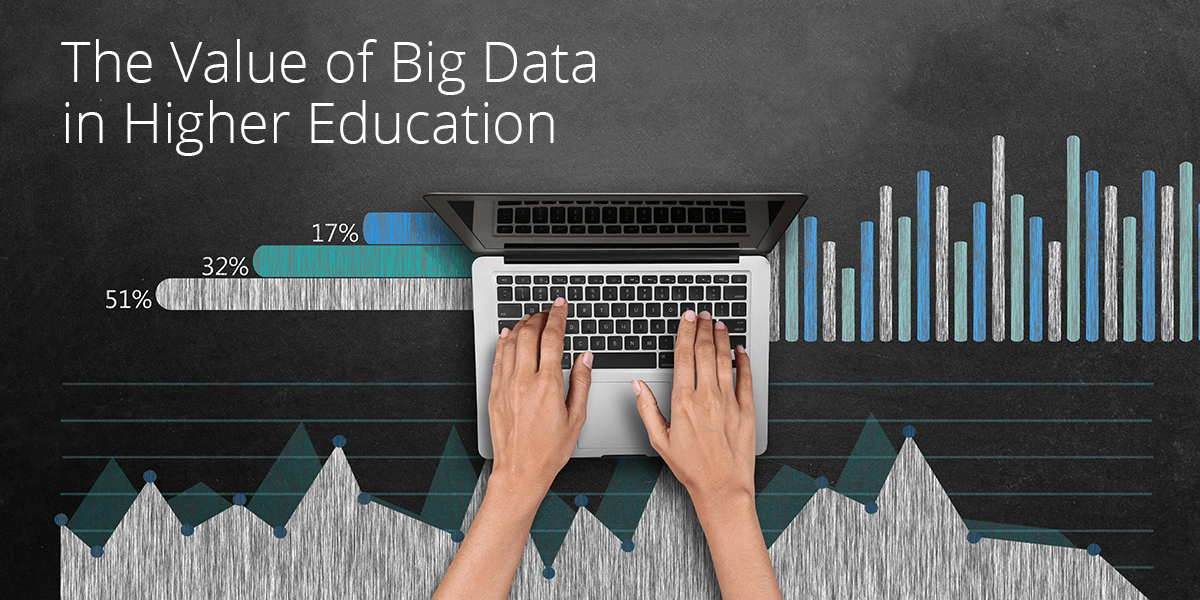The Value of Big Data in Higher Education

For years, the corporate world has been analyzing, sharing and leveraging the power of big data. From predicting consumer behaviors to targeting buyers and improving customer experience, companies are using a robust analytical understanding of consumers to better meet their needs. UnitedHealthcare, for example, utilizes data from its entire membership to discern possible drug interactions and notify those who are potentially affected. Other organizations use big data to focus their resources on customers who are most likely to purchase their products.
Although colleges and universities have access to a wealth of data about potential, current and former students, most underutilize that valuable resource. Used properly, big data can improve student experience, increase enrollment and retention and boost school fundraising—making it an essential component of institutional strategy and policy making.
Supporting Student Success
Big data can help colleges and institutions gain the knowledge they need to create better student experiences and more effective learning environments.
Data on students' enrollment, financing and classroom performance can be combined with behavioral data from sources such as student-professor interactions, student surveys, social media and blogs to provide a more comprehensive view of students' and professors' performances.
That data—combined with information from data.gov and shared data from other colleges and universities—can be used by higher education institutions to compare their curriculums, students and professors to others around the country. This allows institutions to identify key areas for improvement.
According to the authors of Academically Adrift: Limited Learning on College Campuses, more than a third of 2,300 undergraduates surveyed failed to improve their critical thinking skills during four years at a university. Big data can improve that statistic.
Colleges and universities can use data about students' behavior—details such as their financial and work arrangements, course registrations, textbook purchases, class participation, study group activities and library or online resource usage—to help students make better decisions regarding their education. Information gleaned about these aspects of students' lives can be valuable when it comes to keeping them in school and providing them with a better education while they're there.
Georgia State University has been highly successful in doing just that. Tracking 140,000 student records and 2.5 million grades, the university identified 800 factors that put students at risk for dropping out. It then developed an early warning system. When an at-risk indicator occurs, it triggers an alert for early intervention. One of the school's many academic advisors connects with the at-risk student to address the issue.
This big data–driven approach to one-on-one advising, in conjunction with expanded resources like peer tutoring, has resulted in a 22% increase in graduation rates over 10 years. In addition, students complete their degrees an average of half a semester sooner.
Big data can also be used to create self-directed learning tools, recommended courses of study, predictions of future performance and effective course and support services designs.
Recruitment is another area where big data can benefit colleges and universities. For example, an institution can create profiles of applicants who are most likely to enroll—and succeed—by analyzing current and former students' demographic info, performance data and social network activity. Those profiles can then be compared to profiles of prospective students, created using predictive modeling software. This software looks at demographic info, financial aid files, admission office interactions, past performance, social media behavior and more. With this information, colleges and universities can better focus recruitment and enrollment resources.
Improving Connections With Alumni
Using big data to increase the value of an institution's education not only helps improve enrollment and retention, it also has a direct impact on alumni giving. According to an Eduventures Alumni Pulse survey of more than 70,000 alumni, only 15% of alumni who believe the cost of their education exceeded its value donated to their alma mater, whereas 40% of alumni who believe the value of their education exceeded its cost were willing to donate. In other words, alumni are more likely to donate if they believe their education was a good value.
On a more direct level, colleges and universities can use big data to identify likely supporters by examining students' and alumni's current or future earnings or wealth potential. These insights can influence profiling, targeting and outreach to increase alumni giving. Institutions can also use data to improve their communications with alumni.
Implementing Big Data
Implementing big data usage can be an expensive undertaking. Before investing in an initiative, it's important for leadership to understand the institution's primary needs and to set forth a strategic plan that will make the best use of the information.
In addition, IT architecture must address vital information issues. Because of the abundance of personal information involved in data analysis, there must be guidelines on how the information can and cannot be used and shared. Institutions must also decide whether students and alumni can opt out or have control over their data.
When properly utilized, big data can have a big impact on the success of students—and institutions.